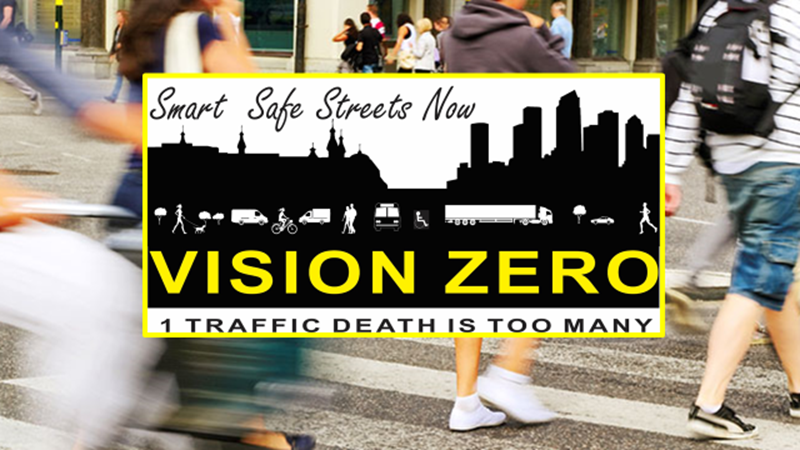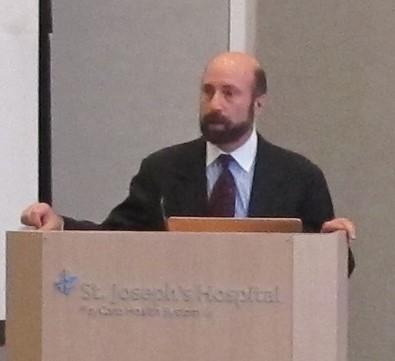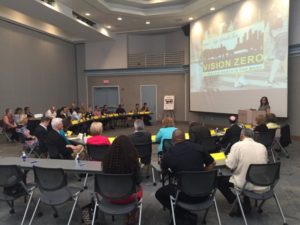 On June 28, MPO Policy Committee members Councilwoman Lisa Montelione, Commissioner Sandra Murman, Wallace Bowers, and Trent Green hosted a roundtable discussion with community leaders on road safety. Traffic deaths in Hillsborough County averaged 167 per year over the last five years — about 33 deaths per year more than the average county.
On June 28, MPO Policy Committee members Councilwoman Lisa Montelione, Commissioner Sandra Murman, Wallace Bowers, and Trent Green hosted a roundtable discussion with community leaders on road safety. Traffic deaths in Hillsborough County averaged 167 per year over the last five years — about 33 deaths per year more than the average county.
An overview of the grassroots Vision Zero movement, now in cities across the nation to bring death rates down, was given by guest speaker Richard Retting, an eighteen-year veteran of the national Insurance Institute for Highway Safety and former Deputy Assistant Commissioner for Traffic Safety with the New York City Department of Transportation. “Vision Zero is traffic safety on steroids,” said Mr. Retting, acknowledging the ongoing work of safety engineers in city and county public works departments and the Florida Department of Transportation.
Richard Retting addresses the Vision Zero task force
As he described, many people in past decades died when their vehicles ran off the side of the road. As a society we could have just said they should have been paying better attention. But instead we asked the question, does a lapse in judgment have to be fatal? And we built guardrails, changed highway designs and required seatbelts, and now people walk away from such crashes.

“Traffic deaths are preventable,” said Mr. Retting, as he described the walk/bike crash problem we still haven’t solved. “This isn’t just about individual drivers. We get what we build for.” His slide stating “Traffic violence is a public health crisis” caught the eye of Dr. Leslene Gordon with the Florida Department of Health. Dr. Gordon’s team has helped neighborhoods conduct walkability audits of local roads. “Engaging our community members is so important,” she told the group, if we are to find solutions that make a difference in peoples’ day-to-day lives.
[divider type=”clear”]
Other suggestions during the roundtable discussion included:
- Spread the word that speed is a killer
- Create a cultural awareness shift as happened with Driving Under the Influence
- Seek partnerships with MADD, AARP, schools & parents, assisted living facilities, churches, and cultural organizations to reach people where they are
- Consistent, 24/7 enforcement of traffic laws, using cameras that can be out there when a patrol officer cannot
- Focus on repeat crash areas and repeat offenders, using data to see if the worst 20% is responsible for 80% of problems
- Use creative strategies to raise awareness, including social media, public art, storytelling
- Take advantage of new flexibility in road design rules, and work with local professional groups like ASHE and ITE to build expertise among practicing engineers
- Understand community needs first
Vision Zero came to the forefront of transportation planning locally after a record breaking number of pedestrian deaths in 2015 inspired the formation of Walk Bike Tampa. This group of committed
advocates urged Tampa City Council, the Hillsborough County Commission, and the School Board to adopt resolutions in support of Vision Zero. A Vision Zero policy establishes a goal of reducing traffic fatalities and serious injuries to zero, typically by a target date. The Hillsborough MPO agreed to sponsor a Vision Zero Action Plan in support of this local effort.

Vision Zero is an approach to road safety that began in Sweden and has been implemented in that country since 1997. Many U.S. cities have adopted Vision Zero, including New York, Chicago, Washington DC, Seattle, Austin, and San Diego. At the core of the worldwide Vision Zero movement is the belief that death and injury on city streets is preventable – in other words, that these aren’t “accidents,” but the result of poor behaviors combined with unforgiving roadway designs. The resulting philosophy is to approach the problem from multiple angles, including targeted education and data-driven enforcement, as well as street designs that emphasize safety, predictability, and the potential for human error.
The Hillsborough MPO is a leader and partner with other local agencies in addressing and mitigating crash rates. Safety is a top priority of the MPO’s Imagine 2040 Transportation Plan and Transportation Improvement Program, and is specifically called out as a component of the MPO’s federally-required Congestion Management Process, reframed here as the Congestion Management/ Crash Mitigation Process.
Last winter, the MPO and its partners sponsored a high school student walk/bike safety video contest to raise awareness among young people of how critically important it is to use crosswalks, bike on the right side, stop at stop signs and avoid distractions. At high schools around the county, 78 students prepared 32 video clips, winners were selected by a Hillsborough Community College media class and announced at the MPO Board, School Board, and Hillsborough County Commission. the videos have been aired by HTV, TBO.com, Baycare Safe Kids, and on morning shows at schools around the county.
The MPO sends a big thank you to community leaders for their ideas, with a shout-out to Baycare, Cigar City Brewing, NAACP, the Downtown Partnership, the Westshore Alliance, the Innovation Alliance, the Sheriff’s Office, and Tampa Police, Hillsborough County, City of Tampa, and the Florida Departments of Transportation and Health.
The second Vision Zero workshop of four will be held on Tuesday, September 27th, at 9:00 am at the USF Connect Building Oak View Room, 3802 Spectrum Blvd. Tampa. Contact Gena Torres if you’d like to be part of the coalition, and stay tuned!

